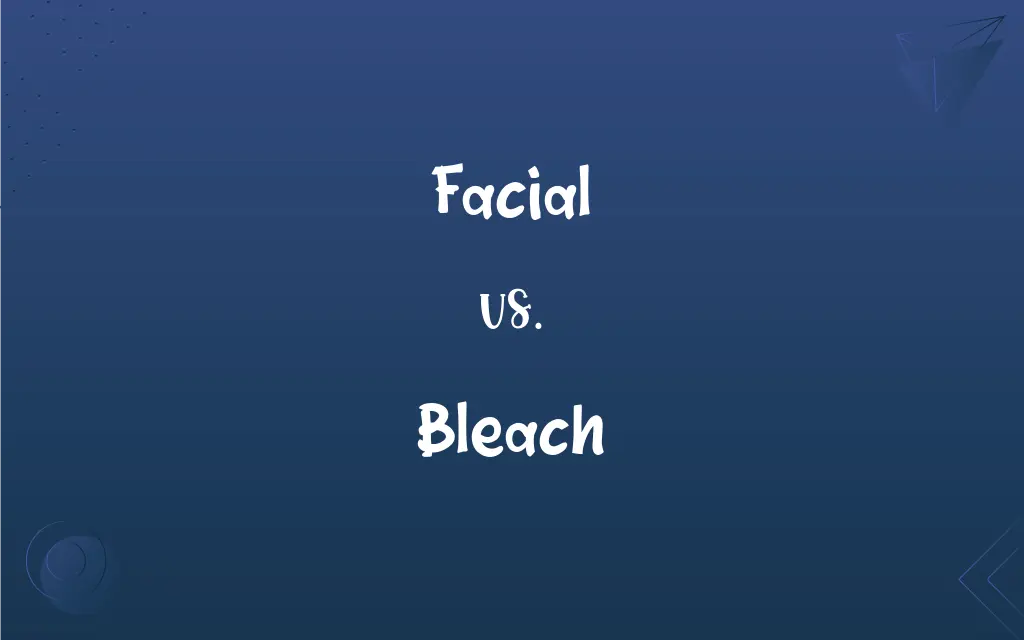Facial vs. Bleach: What's the Difference?
Edited by Aimie Carlson || By Janet White || Published on February 4, 2024
A facial is a beauty treatment for the face, involving cleansing, exfoliating, and nourishing the skin, while bleach is a cosmetic procedure used to lighten hair or skin tone.

Key Differences
Facials are comprehensive skincare treatments focused on improving the health and appearance of facial skin. They typically involve a series of steps including cleansing, exfoliating, steaming, applying masks, moisturizing, and massaging the face. Facials are designed to cleanse pores, remove dead skin cells, and nourish the skin, promoting a clear, well-hydrated complexion. Bleach, on the other hand, is a cosmetic process used to lighten hair or skin. When used on facial hair, bleach lightens the hair color, making it less visible. Skin bleaching involves applying chemical substances to lighten the skin tone or provide an even skin complexion by reducing the concentration of melanin.
The purpose of a facial is to rejuvenate and refresh the skin, addressing specific skin concerns like acne, dryness, aging, and dullness. It's a pampering, relaxing experience often performed in spas or salons by estheticians. Bleaching, in contrast, serves a different purpose: it is used for cosmetic enhancement, either to lighten the facial hair or to achieve a lighter skin tone. It can be done at home or in a salon, but it involves the application of chemicals that can be harsh on the skin if not used correctly.
Facials can be customized according to skin type and individual skin concerns. They often include the use of various skincare products like cleansers, masks, serums, and moisturizers, each chosen to suit the specific needs of the client's skin. Bleach, however, is a more standardized treatment, using chemical agents like hydrogen peroxide or ammonia to lighten hair color. Skin bleaching products may vary in strength and formulation but generally work by reducing melanin in the skin.
Regular facials can improve skin health over time, leading to a clearer, brighter complexion and reduced signs of aging. They are often recommended as part of an ongoing skincare regimen. Bleaching, particularly skin bleaching, is more controversial due to potential side effects and health concerns. It's essential to use bleach cautiously, as overuse or improper application can lead to skin damage.
Both facials and bleach are cosmetic treatments for the face, they serve different purposes and involve different procedures. Facials are focused on improving skin health and appearance through a multi-step skincare treatment, while bleach is used for lightening hair or skin, involving the application of chemical agents.
ADVERTISEMENT
Comparison Chart
Purpose
To cleanse, exfoliate, and nourish facial skin
To lighten facial hair or skin tone
Procedure
Multi-step skincare treatment
Application of chemical agents
Focus
Skin health and rejuvenation
Cosmetic enhancement by lightening
Customization
Customizable according to skin type and needs
Standardized treatment, varies in formulation
Frequency
Recommended regularly for skin health
Used occasionally or as needed
ADVERTISEMENT
Facial and Bleach Definitions
Facial
A facial is a skincare treatment for the face.
She felt refreshed after getting a facial at the spa.
Bleach
Bleach is a cosmetic procedure to lighten hair or skin.
She used bleach to lighten her facial hair.
Facial
A facial is aimed at improving skin health and appearance.
Regular facials have improved the clarity of her skin.
Bleach
Bleach involves the use of chemicals like hydrogen peroxide.
The bleach solution was prepared to lighten his hair color.
Facial
Facials can be customized to address specific skin concerns.
He had a facial that focused on treating acne-prone skin.
Bleach
Skin bleaching aims to achieve a lighter skin tone.
He was cautious about using skin bleach due to potential side effects.
Facial
Facials involve steps like cleansing, exfoliating, and moisturizing.
During the facial, the esthetician applied a hydrating mask.
Bleach
Bleaching can make facial hair less visible.
After bleaching, her eyebrows matched her dyed hair color.
Facial
Facials are often performed in salons or spas by professionals.
She booked a facial treatment at her favorite salon for the weekend.
Bleach
Bleach is used for cosmetic enhancement.
She considered bleaching to even out her skin tone.
Facial
Of or concerning the face
Facial cosmetics.
Facial hair.
Bleach
To remove the color from, as by means of chemical agents or sunlight
Over time, the exposure to sunlight bleached the rug in front of the window.
FAQs
What is a facial?
A facial is a skin care treatment for the face, including steps like cleansing, exfoliation, extraction, creams, lotions, facial masks, peels, and massage.
What are the benefits of a facial?
Facials can cleanse the skin, remove dead skin cells, unclog pores, improve hydration, and provide a relaxing experience.
How often should one get a facial?
Generally, once a month is recommended, but it can vary depending on skin type and needs.
Is bleach harmful to the skin?
Bleach can be harmful and cause irritation, burns, or allergic reactions if it comes in direct contact with the skin.
Can bleach be used for cleaning all surfaces?
Not all. Bleach can damage certain materials and surfaces, so it's important to check compatibility.
How should bleach be stored?
Store bleach in a cool, dry place away from direct sunlight and out of reach of children.
Bleach
Bleach is a chemical used to lighten or remove color, disinfect, or clean, often containing chlorine or peroxide.
What are the uses of bleach?
Bleach is used for whitening fabrics, removing stains, disinfecting surfaces, and lightening hair color.
Can all skin types get facials?
Yes, but the type of facial should be tailored to the individual's skin type and concerns.
Are there any side effects of facials?
Some may experience temporary redness, irritation, or breakouts, especially if they have sensitive skin.
What is facial bleach?
Facial bleach is a cosmetic treatment used to lighten facial hair, making it less visible.
How long does facial bleach last?
Results vary, but generally, it lasts for 2-4 weeks.
Can facial bleach lighten skin tone?
It's primarily for hair, but some may notice a slight lightening of the skin.
Are there any risks to using facial bleach?
It can cause irritation, redness, or allergic reactions, especially in sensitive skin.
Can a facial include bleaching?
Yes, some facials include a bleaching step, particularly for lightening facial hair.
How does one choose the right type of facial?
It depends on skin type, concerns, and goals. Consulting with a skincare professional can help in choosing the most appropriate facial.
How to test for an allergic reaction to facial bleach?
Conduct a patch test by applying a small amount on the skin, usually behind the ear, and wait for 24 hours to check for any adverse reaction.
Is facial bleach the same as hair bleach?
No, facial bleach is milder than hair bleach and is formulated for sensitive facial skin.
Is it safe to use household bleach for facial hair?
No, it's too harsh for the delicate skin on the face and can cause severe irritation.
Can men use facial bleach?
Yes, facial bleach is suitable for anyone looking to lighten facial hair.
About Author
Written by
Janet WhiteJanet White has been an esteemed writer and blogger for Difference Wiki. Holding a Master's degree in Science and Medical Journalism from the prestigious Boston University, she has consistently demonstrated her expertise and passion for her field. When she's not immersed in her work, Janet relishes her time exercising, delving into a good book, and cherishing moments with friends and family.
Edited by
Aimie CarlsonAimie Carlson, holding a master's degree in English literature, is a fervent English language enthusiast. She lends her writing talents to Difference Wiki, a prominent website that specializes in comparisons, offering readers insightful analyses that both captivate and inform.







































































